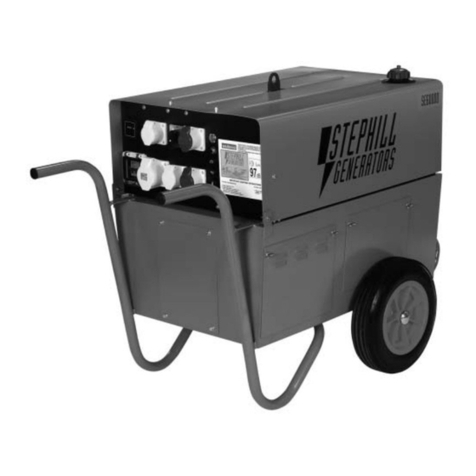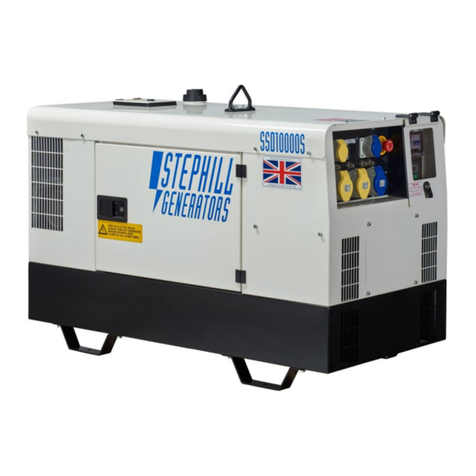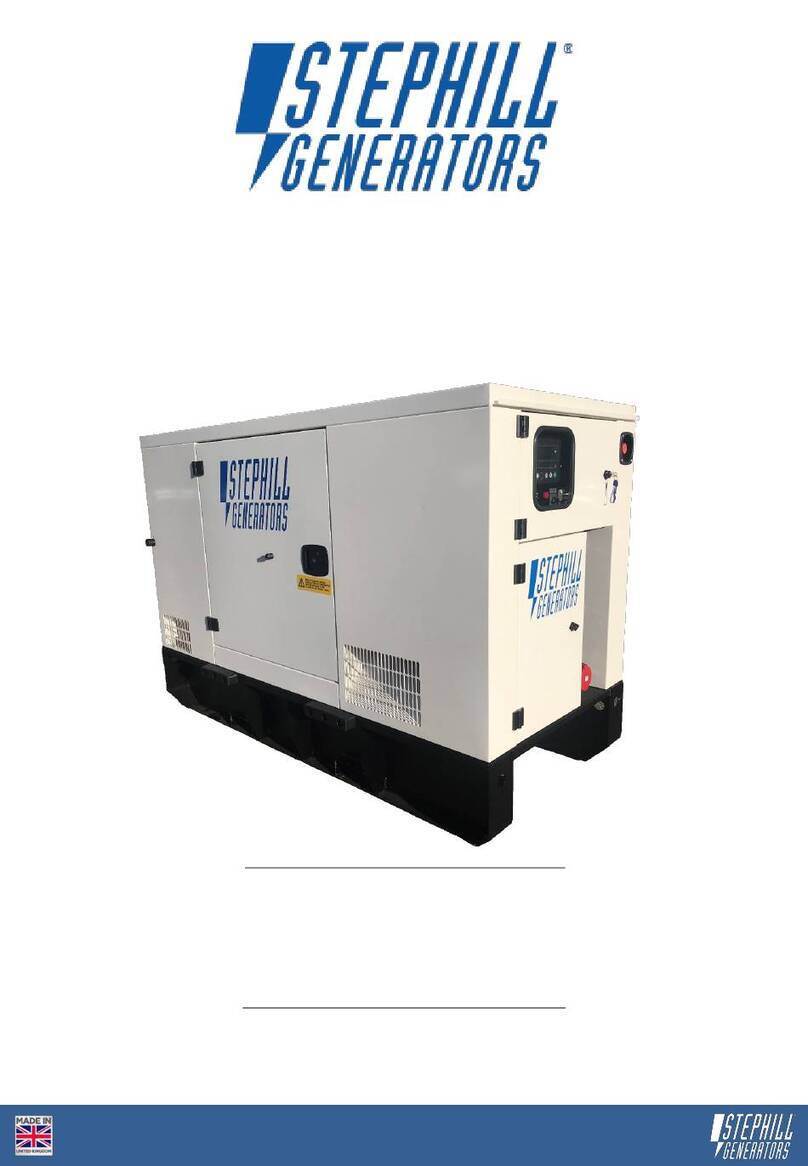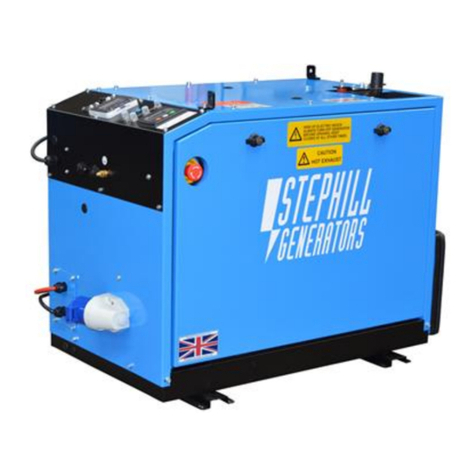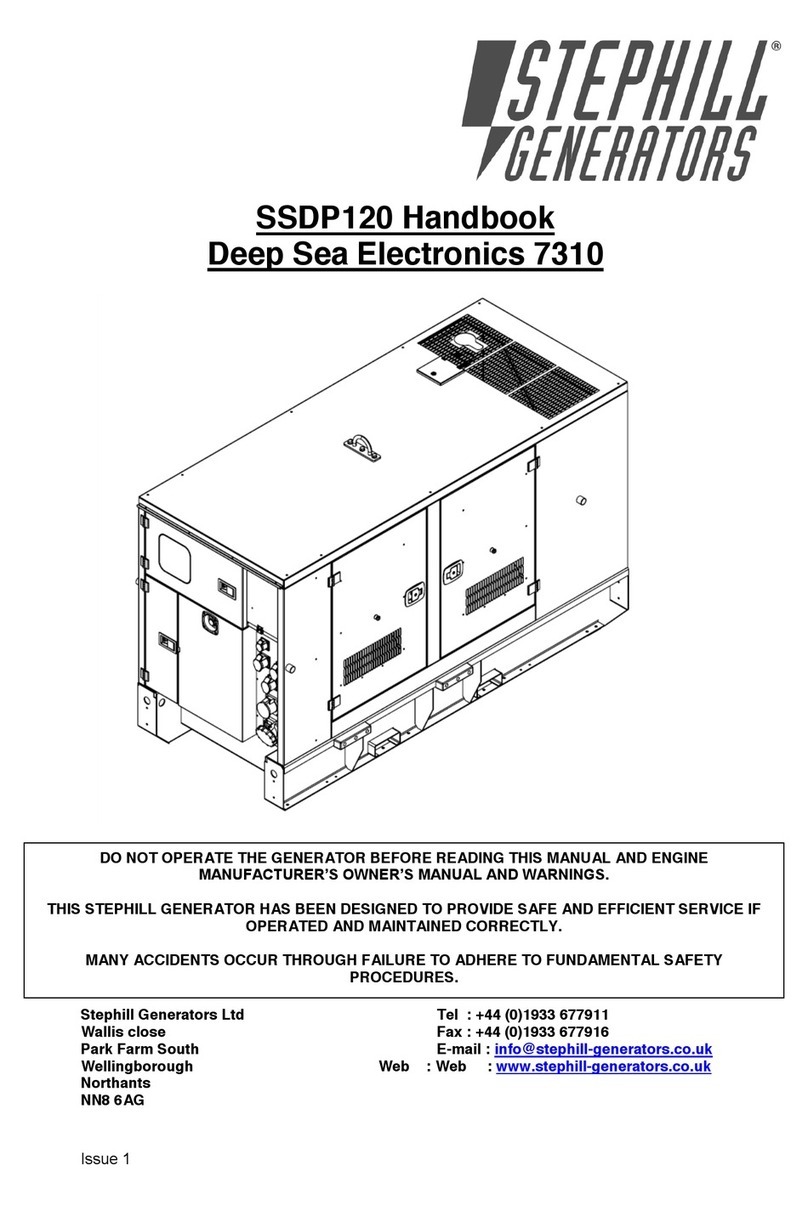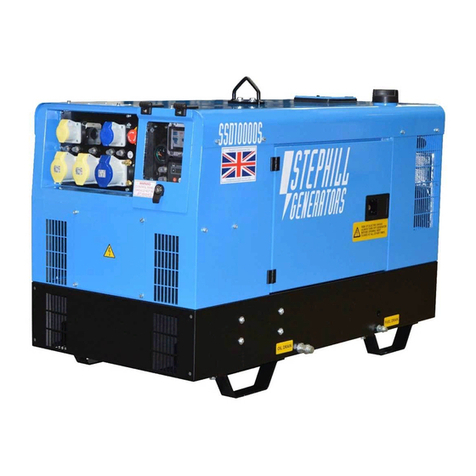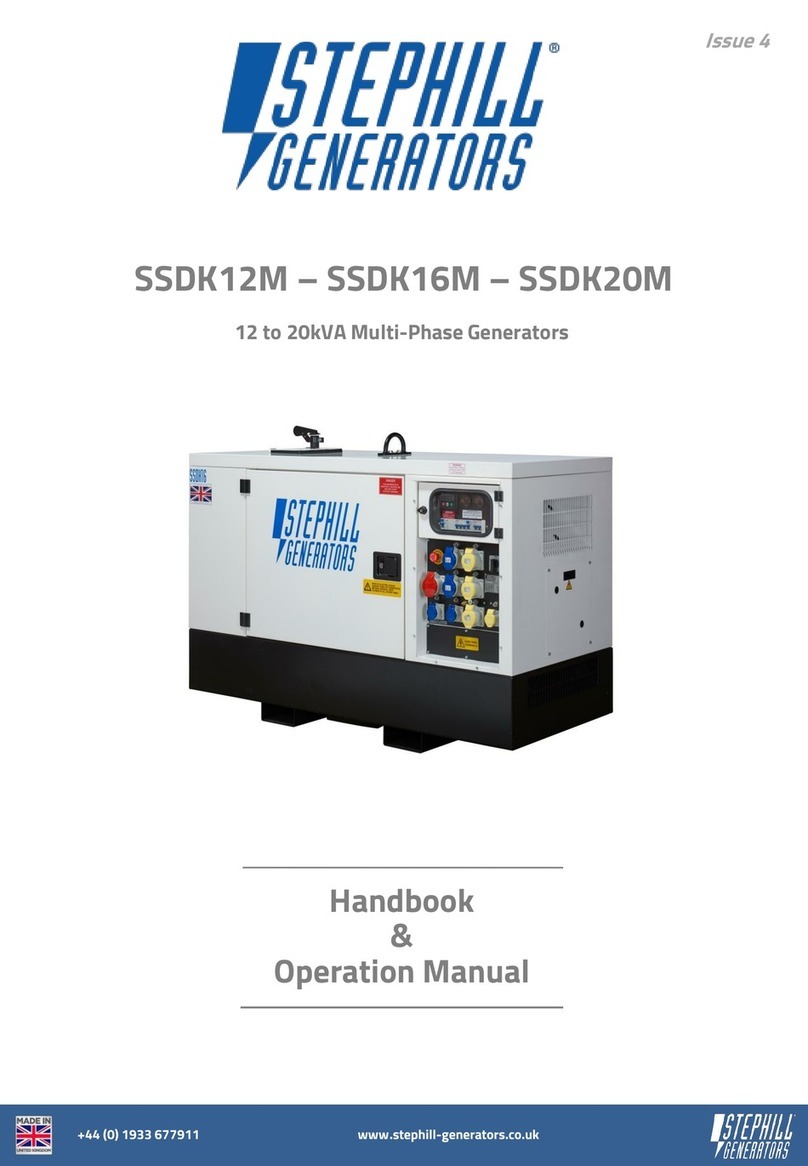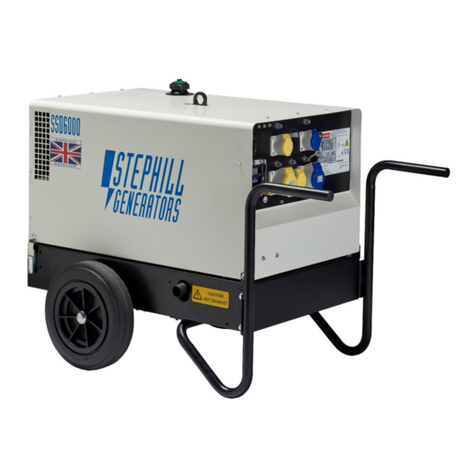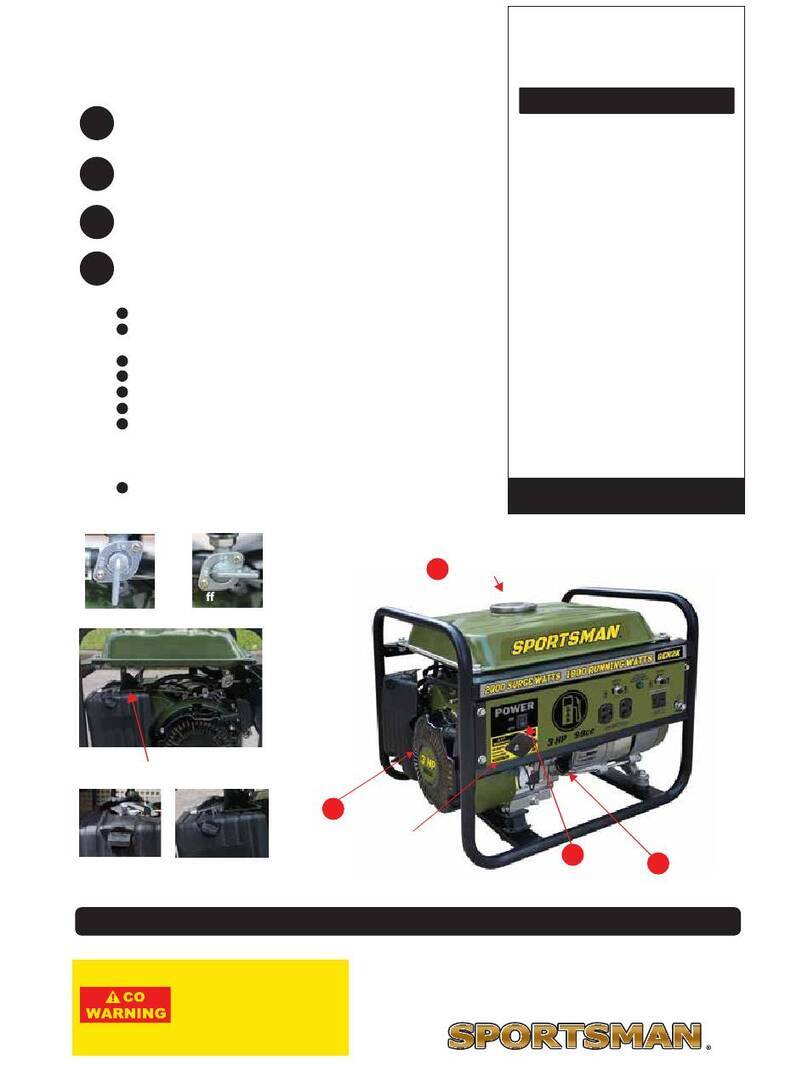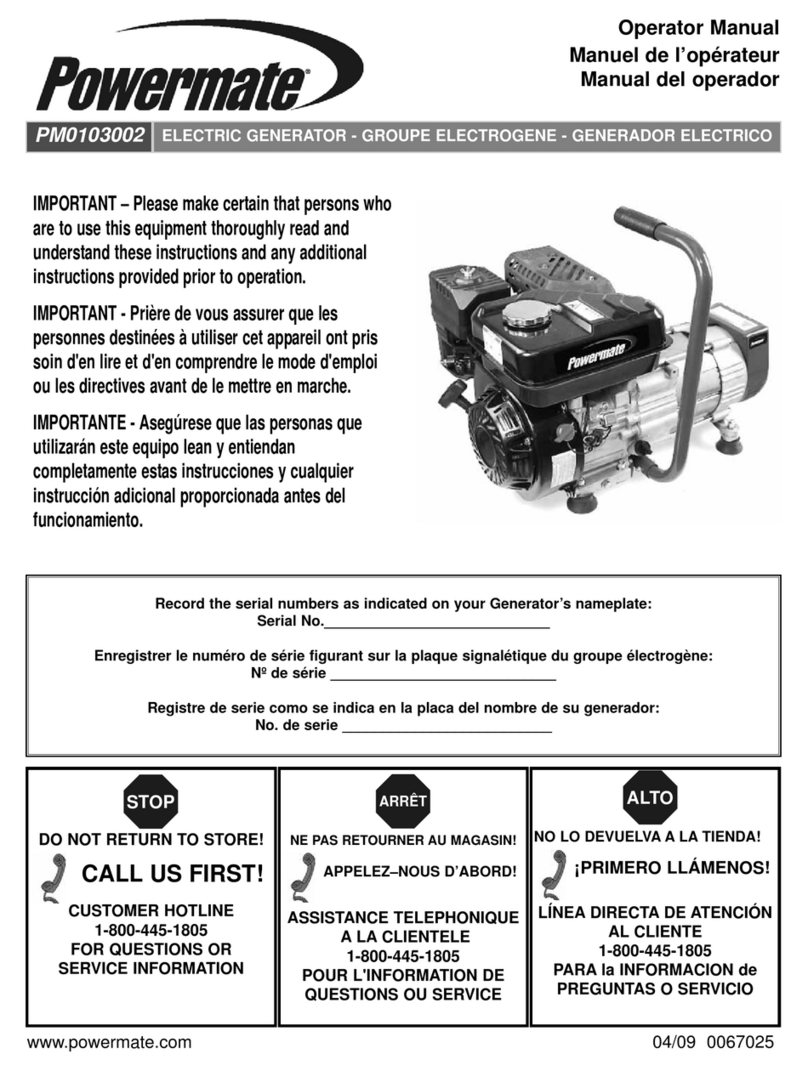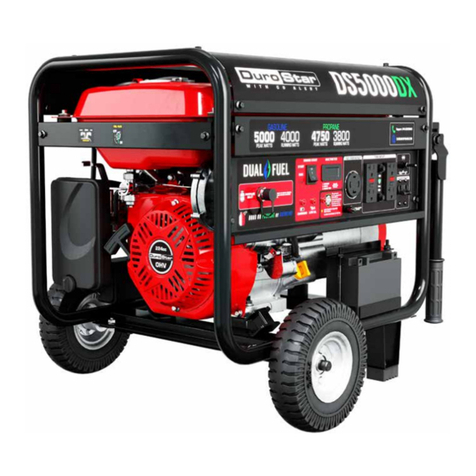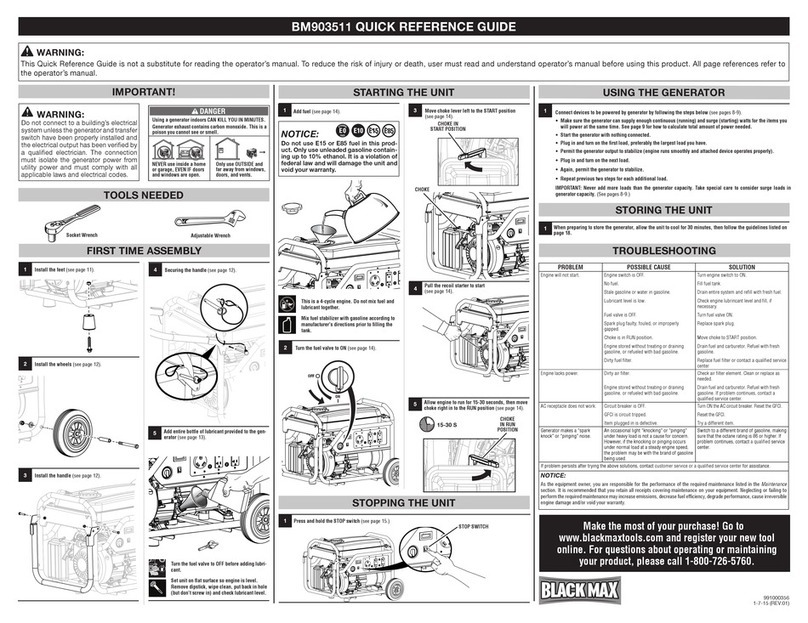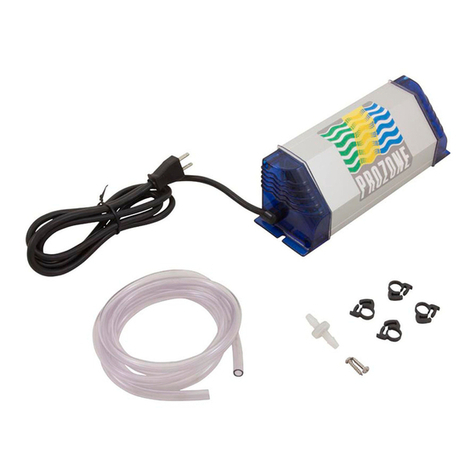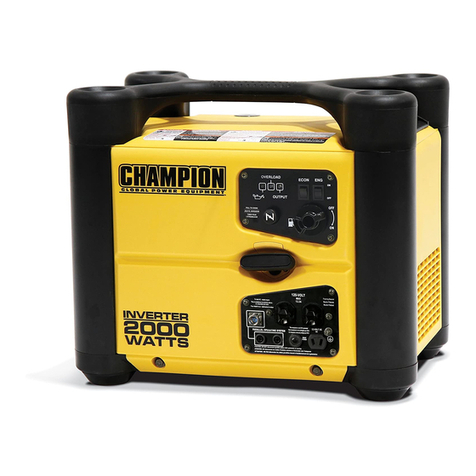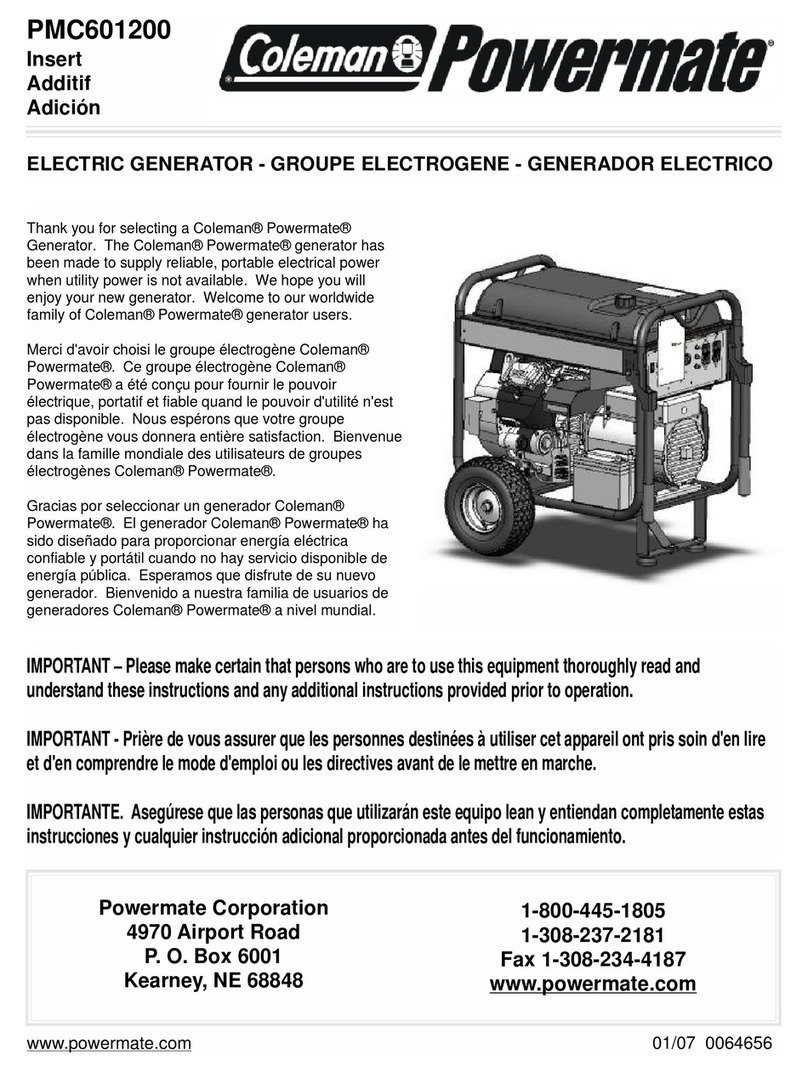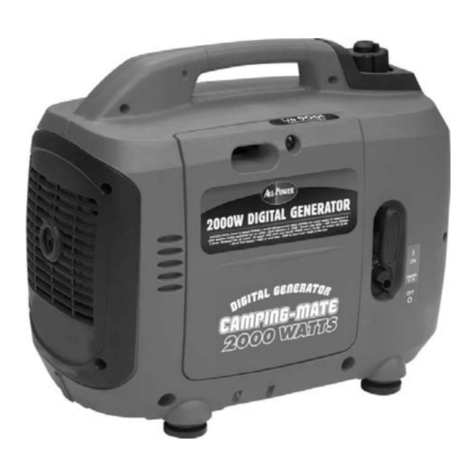Stephill SSDY21M User manual

Issue 1
SSDY21M
+44 (0) 1933 677911 www.stephill-generators.co.uk
Handbook
&
Operation Manual
21kVA Multi-Phase Generators

SSDK12M - SSDK16M - SSDK20M
3 Introduction
13 Operating Instructions
13 Pre-starts Checks
3 Warranty Statement 13 Check Battery Isolator Key - Location
14 Check Oil Level - How to
3 Amendments 14 Adding Engine Oil
15 Check Coolant Level
4 Identification 15 Check Fuel Level
15 Control Panel Checks
5 Specification 15 Starting the Generator - Manual Start
5 AC Output Protection 16 Applying Load
5 AC Output Earthing Method
6 Running Hours
6 Engine 16 Emergency Stop
6 AC Alternator 16 Remote Start/Stop - 2-wire
6 Dimensions & Weights
7 Control Panel Identification
9 Generator Safety 18 Long Term Storage
9 Warning Signage 18 Bleeding the Fuel System
10 Personal Safety
10 Auxiliary Power
18 DSE 3110 Control Module - Overview
11 Operating Environment 18 DSE 3110 Operation
11 Temperature Range 19 Starting Sequence
11 Reference Relative Humidity 19 Timer Icon
11 Reference Barometric Pressure 19 Engine Running
11 Flammable Environment 19 Viewing the Instruments
11 Saline Environment 20 AUTO MODE - Start/Stop Operation
20 Waiting in AUTO MODE
11 Safety Considerations
11 General - UK & EU 20 External Fuel Source
12 Fuel 20 3-Way Valve(s)
12 Lubricating Oil 21 Standard 12V Lift Pump
12 Bunded Fuel Tank 21 Uprated 12V Lift Pump
12 Safe Lifting
12 Earth Connections
21 Fault Finding
12 Fumes 21 Monitoring Systems
13 Noise 21 Before Fault Finding
13 Battery Acid 22 Fault Finding - DSE 3110
13 Fire 25 Fault Finding - General cont.
13 Hot Parts
17 2-wire remote and ATS Auto
Start/Stop Connection Location
Contents
16 Stopping the Generator - Manual
Stop
17 Hard Wire Terminals - Connection &
Location

SSDK12M - SSDK16M - SSDK20M
26 Service and Maintenance
26 Pre-service
26 Engine Service
26 Oil System Service
26 Oil System Location
27 Oil System Service Procedure
27 Alternator Service
27 Road Tow Trailers
27 Trailer Information
28 Safety Precautions
28 Wheels
28 Number Plate
28 Hitch Type
28 Pre-towing/Hitch Up
29 Hitching Method
29 Service Brake
29 Reversing
30 Spares
30 Yanmar Consumable Service Spares
30 Control Panel - AC Components
30 Control Panel - DC Components
30 General Spares
31 Engine Accessories
31 Exhaust System Spares
32 Wiring Diagrams
32 AC Multiphase Wiring - SW12036
33 DC Yanmar 4TNV88 DSE 3110 - SW11081

SSDY21M 3
© Stephill Generators Ltd.
All rights reserved.
Operation with incorrect fuel, lubricating oil or coolant.
Improper repair or use of parts not supplied or approved by Stephill Generators Ltd.
Lack of, or incorrect maintenance.
Issue Date By
Introduction
Warranty Statement
This document has been produced for the owner/user of a Stephill generator. Inside this manual you will find
important safety, operating, maintenance and fault finding information.
The information contained within this manual is based upon the current data available before print. Due to
constant improvements on our products some information contained within this manual may change without
warning. Therefore Stephill Generators Ltd reserve the right to alter specifications as and when situations
demand without warning or obligation.
No part of this material may be reproduced in any form by any means without the written permission of
Stephill Generators Ltd.
All equipment supplied by Stephill Generators Ltd carries a warranty of 12 months from date of despatch.
During the warranty period, should the plant fail due to faulty design, materials or workmanship by Stephill
Generators Ltd or it’s sub-contractors, we undertake to rectify the fault. Stephill Generators Ltd will accept no
responsibility whatsoever for equipment that has failed due to;
Fair wear and tear, misuse, negligence, accidental damage, improper storage and incorrect starting / warm-
up / run-in or shutdown.
No warranty claim will be considered by Stephill Generators Ltd unless any defective parts are available for
inspection by us, or our nominees, to determine the reason or cause of failure, and Stephill Generators Ltd is
given the option of repair or replacement.
Stephill Generators Ltd are not responsible for incidental or consequential damages, downtime, or other
costs due to warrantable failure, and unauthorised alterations made to any product supplied by Stephill
Generators Ltd.
Amendments
Amendment

SSDY21M 4
Fig.1
1Generator model type
2AC voltage output(s)
3Standby rated power, kVA & kW
4Continuous prime rated power, kVA & kW
5Number of phases
6Rated output frequency
7Power factor
8Unique serial number
9Relevant maximum current ratings, amps
Total fuel tank capacity
Generator performance class
MGW - Mass Gross Weight(s)
11 UKCA & CE indicates the generator meets the directives listed on the Declaration of Conformity
Each Stephill generator will have a Serial/Data plate fitted to the set. In most cases this can be found on the
control/socket panel of a SSDY21M generator. Below is an example of the Serial/Data plate.
Identification
Item No.
10
Description
1
2
3
4
9
11
10
5
6
7
8

SSDY21M 5
400V 3Ph
MCB overload/short circuit protection - RCD earth leakage protection.
230V 1Ph
115V 1Ph
Thermal reset button overload protection for each socket.
Note
MCB = Miniature Circuit Breaker
RCD = Residual Current Device
All are suitably rated for the generator model type.
400V 3Ph - Neutral (star point) bonded to earth.
230V 1Ph - Neutral bonded to earth.
115V 1Ph - Floating earth.
AC Output Protection
AC Output Earthing Method
Frequency
Phase
LWA
dBA @ 7M
3 Ph / 1 Ph
120 Litres
52.5 - 50.0 Hz
21.1kVA / 16.9kW
19.2kVA / 15.4kW
19.8kVA / 15.9kW
18.0kVA / 14.4kW
89
64
400V / 230V & 115V AC
(ESP) Standby Power: Applicable for supplying power to varying electrical load for the duration of power
interruption of a reliable utility source in accordance with ISO 8528-1 under the agreed operating conditions
with the maintenance intervals and procedures being carried out as prescribed by the manufacturers.
(COP) Continuous Power: Applicable for supplying power to electrical load for unlimited hours in accordance
with ISO 8528-1 under the agreed operating conditions with the maintenance intervals and procedures being
carried out as prescribed by the manufacturers.
Voltage
Cont. Power (COP) - 1Ph
Specification
SSDY21M
Fuel Tank Capacity
Cont. Power (COP) - 3Ph
Standby Power (ESP) - 1Ph
Standby Power (ESP) - 3Ph
As standard the SSDY21M Stephill generator is configured as a multiphase generator with both single phase
(1Ph) and three phase (3Ph) outputs.
MCB overload/short circuit protection - RCD earth leakage protection - Thermal reset button overload
protection for each socket.

SSDY21M 6
Running Hours
43 hours @ 2.8 L/h
50% Load
25% Load
28 hours @ 4.2 L/h
86 hours @ 1.4 L/h
21 hours @ 5.6 L/h
Yanmar 4TNV88-B
4
2.19L
Standby 18.9 kW
Continuous 17.2 kW
Engine
EU Stage V
Type
Emissions Certification
Cylinders
Water Cooled
Cooling
Displacement
Weight - Dry
Weight - Wet
AC Alternator
Net Engine Power
75% Load
100% Load
Rpm
1500
Dimensions & Weights
Skid Mounted
Meccalte ECP28-VL4 C
694 KG
Road Trailer Mounted
Weight - Dry
Type
Weight - Wet
Length 1800mm Width 800mm Height 1270mm
Length 3405mm Width 1335mm Height 1510mm
794 KG
820KG
920 KG

SSDY21M 7
Fig.2
Fig.3
1A Reset Button (top) - AC
2A Reset Button (bottom) - DC
Description
Item No.
1
Fuel Pump Prime Button
2
DSE 3110 Control Module
3
Fuel Gauge
4
5
Temperature Gauge
8
400V 3Ph 3 Pole MCB
9
230V 1Ph 2 Pole RCD
10
230V 1Ph 2 Pole MCB
Control Panel Identification
Below in Fig.3 & Fig.4 are close-up details of the components found on this
control panel.
Description
Item No.
7
400V 3Ph 4 Pole RCD
6
Oil Gauge
Fig.2 shows a typical standard multiphase control panel configuration found
on the SSDY21M.
The control panel is made up of engine and generator controls (DC) and the
generator output (AC).
7
3
4
2
8
9
10
1
5
6

SSDY21M 8
Fig.4
230V 16A 1Ph Socket Outlet
(only operates in 400V setting)
8
400V 32A 3Ph Socket Outlet
Emergency Stop
Item No.
2
11
12
230V 32A 1Ph Socket Outlet
115V 32A 1Ph Socket Outlet
Voltage Selector Switch
3
30A Reset Button - Fitted to all
32A 1Ph socket outlets.
1
230V 16A 1Ph Socket Outlet
7
Description
Item No.
Description
9
Brass Earth Stud
16A Reset Button - Fitted to all 16A
1Ph socket outlets.
115V 16A 1Ph Socket Outlet
Serial/Data Plate
4
5
6
10
1
2
3
4
5
6
7
8
9
10
11
12

SSDY21M 9
Warning Signage
b) Located on both main canopy doors.
e) Located near the control panel.
Before using this equipment and to avoid personal injury, all warnings shown on the machine should be
observed. The warning signage should be checked for legibility and any that have become damaged should
be replaced.
Carefully read and understand the instructions provided. If there is anything you do not understand DO NOT
attempt to use this generator. Contact your supplier for advice.
a) Located behind the control panel cover near the
DSE 3110 control module.
c) Located on the engine end of the
canopy near the exhaust outlet.
Generator Safety
d) Located on top of the canopy near the
coolant filler flap for the radiator access.
WARNING
BEFORE STARTING
●READ HANDBOOK AND SAFETY ADVICE
●CHECK OIL LEVEL
●DO NOT ADJUST ENGINE SPEED
WITHOUT SUITABLE TEST EQUIPMENT
a)
b)
c)
d)
e)
f)

SSDY21M 10
f) Located near the control panel.
g) Located near the control panel.
h) Located below the control panel.
• Do not climb on the generator - dents may cause overheating of the acoustic lining.
• Keep well clear of any moving parts on the generator at all times.
• Keep children and pets away from the generator and operating area.
• Test safety features often, emergency stop button and RCD (residual current device).
• Keep the generator canopy doors shut while running and locked if possible.
Do not remove covers and attempt to work on the generator while the engine is running.
Check the rating and electrical safety of the load before connecting the generator.
Equipment should never be connected that in total exceeds the specified rating of the generator.
Personal Safety
Installation of the generator as a standby or secondary power source should only be undertaken by a fully
qualified electrician using the appropriate means of isolation from the mains supply. Installation must comply
with all applicable laws, electrical codes and wiring regulations.
Auxiliary Power
• Do not cover the generator as this can obstruct air inlet and outlets on the canopy which can cause the
generator to overheat and cause permanent damage..
The electricity produced by an engine driven generator is very similar to mains AC electricity and should be
treated accordingly.
f)
g)
h)

SSDY21M 11
Stephill generators must not be used in a flammable environment.
Operation of the machine in a saline environment will require additional corrosion protection.
2008 No. 1597 The Supply of Machinery (Safety) Regulations 2008
2016 No. 1091 The Electromagnetic Compatibility Regulations 2016
2001 No. 1701 Noise Emission in the Environment by Equipment for use Outdoors Regulations 2001
2012 No. 3032
2006/42/EC The Machinery Directive
2014/30/EU
The Electromagnetic Compatibility Directive
2000/14/EC The Noise Emission in the Environment by Equipment for Use Outdoors Directive
2011/65/EU The Restriction of Hazardous Substances Directive
* Declaration of Conformity availble from
Flammable Environment
Reference Relative Humidity
General - EU*
Safety Considerations
General - UK*
Restriction of the Use of Certain Hazardous Substances in Electrical and Electronic
Equipment Regulations 2012
The generator should always be operated on level ground and be able to bear its weight. Ensure the
generator canopy is not obstructed to allow cool air to enter the set and hot expelled air to escape.
Temperature Range
Reference Barometric Pressure
Saline Environment
Operating Environment
The standard reference condition for total barometric pressure is 1 bar. This corresponds to an altitude of
approximately 100m. Above 100m the rated power must be reduced.
A temperature range between -15⁰C and +45⁰C are the normal limits of operation. Operating outside the
range will require additional modifications.
The standard reference condition for relative humidity is 30%. Above this value the rated power must be
reduced.
technical@stephill.co.uk

SSDY21M 12
Lifting equipment should never be attached directly to the engine and/or alternator to fully lift the generator
except only if lifting engine and/or alternator.
All Stephill products are fitted with an earth stud on the control panel this must be connected to an earthing
system or spike. Any earth spike required is dependant on the local conditions of use. The size is determined
by reference to current IEE regulations or to a competent electrician.
Make sure that the Generator is at least 2 metres away from any building during operation. Operate in a well
ventilated unconfined area, so that fumes can be properly dispersed. Silencer outlet should be facing an open
area to prevent fumes being recirculated. There is the danger of asphyxiation due to exhaust gases.
Inhalation of poisonous exhaust fumes can lead to serious injury or death. The generator must not be used in
a poorly ventilated or enclosed area.
Lubricating Oil
Safe Lifting
Bunded Fuel Tank
The SSDK-Range generators are fitted with a secondary fuel containment system, a bunded fuel tank. This will
require inspecting on a regular basis and drain accordingly. Any liquid drained from the bund/tank must be
treated as waste contaminated fuel/oil and disposed of correctly.
New oil presents no hazard following short term exposure. Lubricants in particular used engine oil, are
potentially carcinogenic. Direct contact should always be avoided by wearing suitable rubber gloves when
handling them. Used oil should not be allowed to contact the skin. If this does occur, wash off quickly with a
proprietary hand cleanser.
Warning Stephill Generators Ltd stress that he ultimate responsibility for ensuring the generator meets with
local/national regulations rests with the user.
Fuels and lubricants are a potential source of fire. Be careful not to spill fuel, clean up any spillages.
Inhalation or swallowing of diesel should be avoided. If in doubt seek medical advice. All other forms of
contact are an irritant and therefore should also be avoided. If skin contact is made wash with soap and
water.
DO NOT ATTEMPT TO LIFT THE GENERATOR WITHOUT PRIOR CHECKS TO THE LIFTING
SYSTEM AS INDICATED ABOVE
Fumes
Earth Connection
Where mechanical assistance is used in lifting machines, ensure the lifting eye is used, and that all
components used to lift the machine are within their Safe Working Load (SWL).
The integral lifting beam and associated lifting eye on the generator should be regularly checked for signs of
damage or gross corrosion.
Fuel
All nuts and bolts associated with the lifting beam and eye should be regularly checked for tightness and
corrosion.
technical@stephill.co.uk

SSDY21M 13
This is corrosive and irritant by all forms of exposure. If skin contact is made wash with clean water.
Before any attempt to start the generator please follow these important guidelines.
Isolator key location
Open the main canopy door on the control panel side of the generator - Fig.5 & Fig.6
Fig.6
Fig.5
To switch OFF the 12V battery supply, push down and turn the red key counter-clockwise to release .
Operating Instructions
Fire
Ear protection may be required depending on the combined noise level of the Generator, auxiliary load and
the operator’s distance from it and the length of exposure. (Noise at Work Regulations 1989)
Ensure that suitable fire extinguishers (AFFF or CO2) are kept within close proximity of the generator. Do not
cover, enclose, or obstruct the airflow to the generator during or shortly after use, due to fire hazard or
damage to the generator from overheating. Allow the generator to cool after use before storing away. Keep
all inflammable objects clear of the generator.
STEPHILL GENERATORS LTD STRESS THAT THE ULTIMATE RESPONSIBILTY FOR THE
SAFE USE OF THE GENERATOR RESTS WITH THE USER.
Check Battery Isolator Key - Location
To switch ON the 12V battery supply, insert the red key and turn to lock into position.
The 12V battery supply has been fitted with a red "Battery Isolator Key". This is to isolate the 12V battery
from the engines 12V DC system when not in use, transportation and when working on repairs/servicing
safely.
Noise
Pre-start Checks
Battery Acid
There is the danger of burns as parts of the generator will become very hot during use. No part of the engine,
alternator or exhaust must be touched during or shortly after operation. Do not operate the generator unless
all guards are in place. There is a risk of burns or serious mechanical injury.
Hot Parts

SSDY21M 14
It is recommended to check the oil level BEFORE EVERY START OPERATION - Ref. Fig.7.
Ensure the generator (engine) is on level ground to ensure the correct oil quantity is measured.
● Check the engine oil level before starting or more than 5 minutes after stopping the engine.
● Remove the oil level gauge, wipe it clean and reinstall it.
● Take the oil level gauge out again, and check the oil level.
Fig.7 shows the oil fill and oil dipstick locations on the Yanmar 4TNV88.
Fig.7
(1) Oil Level Gauge - Dipstick (2) Oil Full Level
(4) Oil Filler Cap (3) Oil Low Level
(5) Engine Oil Fill Location
Check Oil Level - How To
Adding Engine Oil
Add oil If the level is low. Do not fill past the high mark on the dipstick (2). WARNING - Never overfill the
engine with oil. Engine damage can occur.
Refer to engine owners handbook supplied with each generator for oil specification, viscosity and typical
capacity. Alternatively navigate to the Service section at
www.stephill-generators.co.uk

SSDY21M 15
Refer to engine owners handbook supplied with each generator for further information.
Ensure that all main MCB's are in the "OFF" position (switch down) - Ref Fig.3.
WARNING - Never try to start the generator with load connected.
Once all the pre-start checks have been made you can then start the generator. Follow the procedure below:
While holding down the fuel pump prime button you should be able to see the gauge needle rise and rest to
indicate a level, also you should hear the fuel pump operating.
It is recommended to check the water/coolant level of the radiator BEFORE EVERY START OPERATION - Ref.
Fig.8.
The radiator is provided with a recovery tank (expansion vessel) , check the water/coolant is between the
"FULL" and "LOW" marks - Ref. Fig.8.
While the generator is at standstill you will notice the fuel gauge on the control panel will be showing empty
"no fuel".
To check the fuel level in the generator fuel tank you can energise the fuel gauge by pressing and holding the
fuel pump prime button on the control panel - see Fig.2 & Fig.3.
Check Coolant Level
This is a basic operation guide, refer to the DSE 3110 Control Module - Overview within this handbook for an
in-depth view/use of the DSE 3110 control module.
Check Fuel Level
Control Panel Checks
Fig.8
Starting the Generator - Manual Start
Recovery Tank / Expansion Vessel
Full Level
Low Level

SSDY21M 16
Press the button until the is displayed on the LCD screen.
A red LED flashes above the button.
Now the generator is ready to receive load. Select the desired AC voltage with the AC voltage switch.
Plug the load into the relevant AC voltage socket on the control panel.
Switch the main MCB to "ON" (switch up) position on the control panel.
You can then safely stop the generator.
Press the button and the generator will immediately stop.
The DSE 3110 control module has a 2-wire Remote Start/Stop function. This is a volt free connection, closing
two contacts will start and allow the generator to run. Open the contacts and the generator will stop and the
DSE 3110 module will wait for the next start request.
Press the button once more, the icon rotating will be displayed on
the LCD screen. This will continue to rotate for approximately 10 seconds.
The generator will then crank and start.
The icon will be displayed on the DSE 3110 module when an Emergency Stop request is
made.
Stopping the Generator - Manual Stop
Remote Start/Stop - 2-wire
The Emergency Stop button is located on the control panel. It must ONLY be used for emergencies
only.
Emergency Stop
Applying Load
WARNING - Using the Emergency Stop button regularly for a standard stop request can cause the 12V
battery to drain. This may effect the starting of the generator.
Before stopping the generator it is recommended to switch off the load from the generator by switching the
main MCB on the control panel to the "OFF" position (switch down).

SSDY21M 17
Fig.10
Fig.12
Fig.11
400V - M6 threaded stud - Maximum tightening torque to 6.8Nm.
230V - M8 threaded stud - Maximum tightening torque to 16.5Nm
Use the black plate to mount cable gland(s) to secure the trailing cable into position.
WARNING - The plate MUST be fitted when running the generator - Risk of Electric Shock.
Once the correct connections have been made to the remote start terminals the DSE 3110 control module
will require activating to an AUTO MODE - See -DSE 3110 Control Module - Overview . It will then be ready
to accept a remote start request.
2-Wire Remote and ATS Auto Start/Stop Connection Location
Hard Wire Terminals - Connection & Location
Below the main control panel is a "HARD WIRE" facility. Once the black plate has been removed you will see
both the 230V single phase and 400V three phase terminal connections - Fig.11. Yellow labels under the
terminal connections indicate the connections - Fig.12.
When connecting to the hard wire terminals ensure the cable and crimps are the correct size. If unsure seek
advice from a qualified electrician.
Fig.9
Below the main control panel is a "HARD WIRE" facility. Once the black plate has been removed there is a
small push-on connector block for the remote and auto start/stop connections. Refer to the DC wiring
diagram at the back of this handbook or corresponding ATS handbook for the relative terminal positions -
Fig.9 & Fig.10.

SSDY21M 18
For storage or long periods of inactivity, Stephill Generators recommend the following:
Before the generator is used after long term storage, all fuels and oils should be replaced.
The battery isolator switch should be switched off.
Fig.13 Fig.14
Fig.14 - Instrument view order.
DSE 3110 Control Module - Overview
Long Term Storage
The DSE 3110 control module is used to start/stop and monitor key elements of the engine and main AC
alternator. Fig.13 show the layout and control buttons.
Generator mounts, pipes and hoses should be checked to ensure that they are un-perished following
extended periods of storage.
The generator should be stored in a clean dry area, ideally having a reasonable constant ambient
temperature, and ideally not below freezing.
DSE 3110 Operation
Generators should be stored with oil filled to the correct capacity; Storage periods of 18 months and over
may require special lubricants and treatments. If so please seek further advice from the engine
manufacturer.
After changing the fuel filters during a service the fuel system may require any air to be removed. The SSDK-
range generators have a Fuel Pump Prime Button fitted on the control panel - See Fig.2 & Fig.3. Ensuring the
fuel tank has an adequate fuel level, press and hold the Fuel Pump Prime Button down for approxiamatley
60 seconds to bleed the fuel system.
Bleeding the Fuel System
Engine Speed
Generator Volts (AC)
Generator Frequency
Engine Run Time
Battery Volts (DC)
Page Order

SSDY21M 19
Once a start request is made the DSE 3110 will energise the pre-heat relay over a period of 10 seconds.
Once the engine is running and all starting timers have expired, the animated icon is displayed.
Fig.14 (above) shows the page order when pressing the navigation button.
When the module is controlling the engine (starting and stopping) an animated (rotating) timer icon will be
displayed in the icon area to indicate that a timer is active, for example cranking time, crank rest, stopping
It is possible to scroll to display the different pages of information by repeatedly operating the navigation
button.
Once selected the page will remain on the LCD display until the user selects a different page or after an
extended period of inactivity, the module will revert to the status display.
When scrolling manually, the display will automatically return to the Status page if no buttons are pressed for
the duration of the LCD Page Timer.
Engine Running
Viewing the Instruments
Engine Running
Then the DSE 3110 will then attempt to crank the engine by operating the starter motor relay and also the
fuel pump relay.
When the engine fires, the starter motor is disengaged. (The DSE 3110 de-energises the starter motor relay
once it detects an output frequency (Hz) from the main alternator).
Timer Icon
If the engine fails to fire during this cranking attempt then the starter motor is disengaged for the crank rest
duration after which the next start attempt is made.
Should this sequence continue beyond 3 attempts, the start sequence will be terminated and the Failed to
Start icon is displayed on the LCD screen.
Timer Icon
Starting Sequence
(See Fault Finding - DSE 3110)
Failed to Start
Table of contents
Other Stephill Portable Generator manuals
Popular Portable Generator manuals by other brands
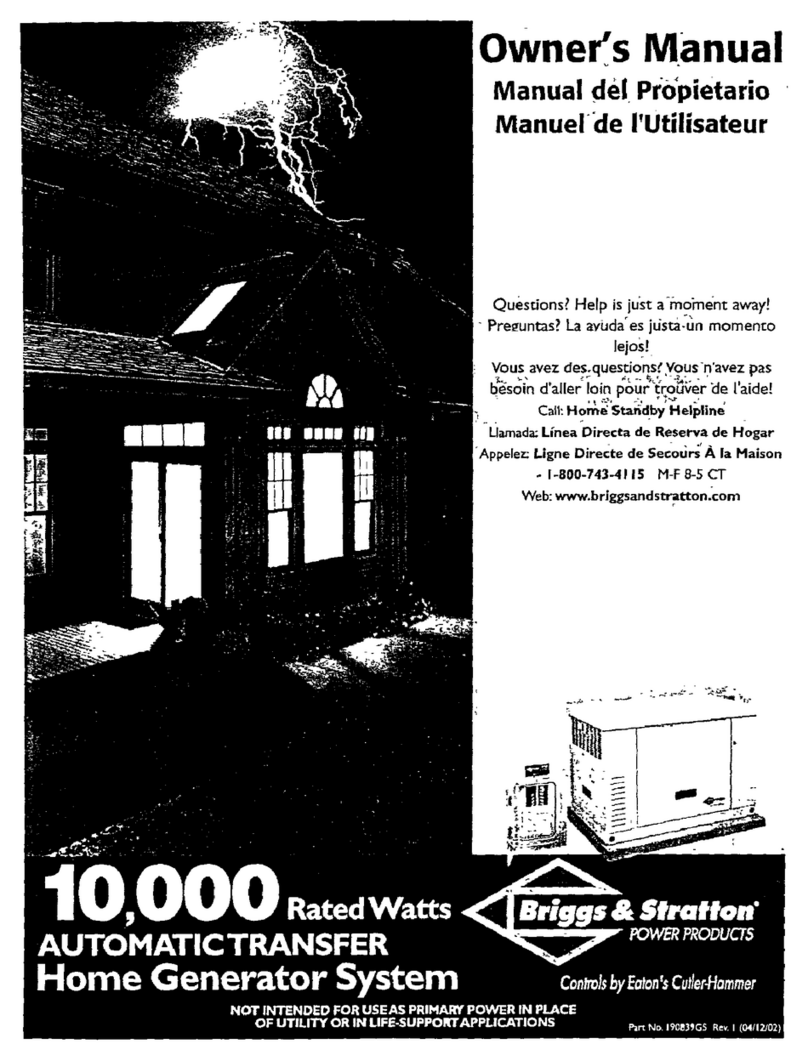
Briggs & Stratton
Briggs & Stratton 190839GS owner's manual

EcoFlow
EcoFlow Detachable wheels & telescopic handle Quick installation guide
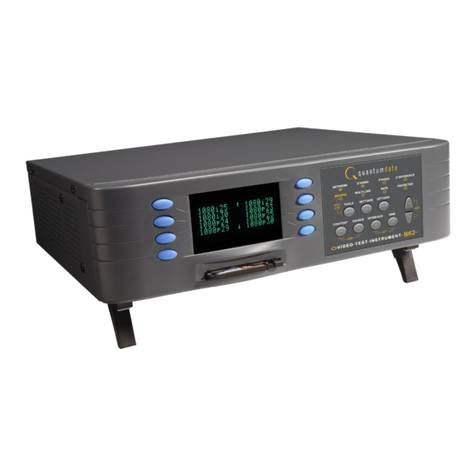
Quantum Data
Quantum Data 881 user guide
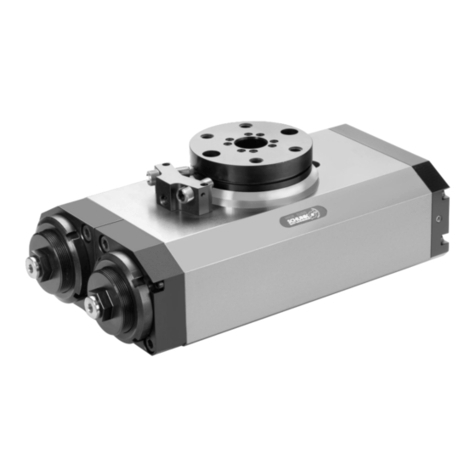
SCHUNK
SCHUNK HSE 28 Assembly and operating manual
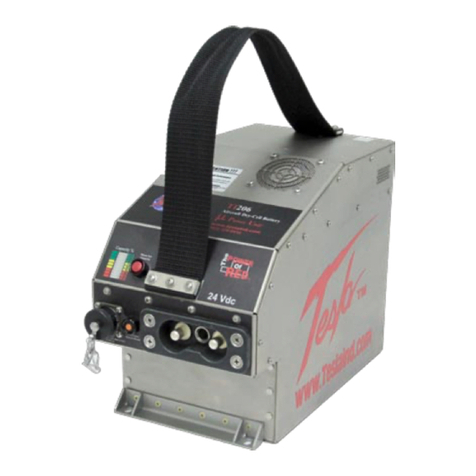
Tesla
Tesla TI206 MPU-24 user manual
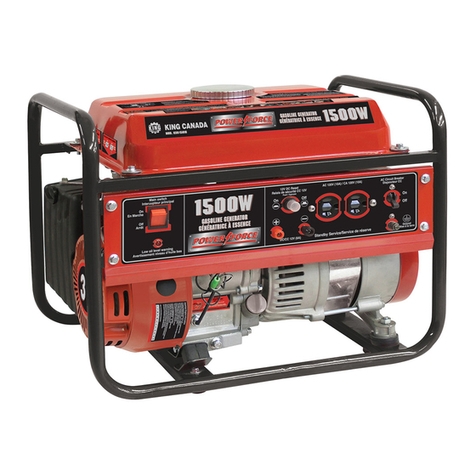
King Canada
King Canada KCG-1501G instruction manual
